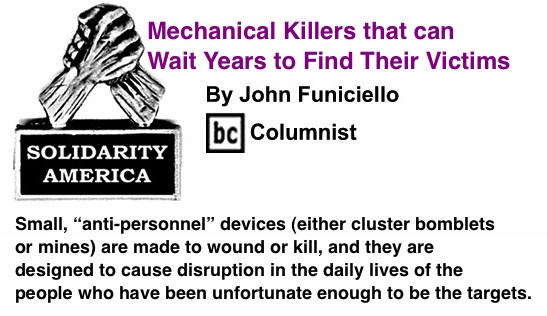




Whether
dropped from aircraft, shot from artillery pieces, or delivered by
missile, cluster bombs can disperse dozens or even hundreds of
so-called “bomblets” that can lie in fields for years, waiting for the
unsuspecting child, farmer, or pastoralist to pick it up or otherwise
disturb its rest.
This is what happens every day in a number of countries that have been
the scenes of battles and of wars, even though the overt hostilities
have ceased long ago. By one estimate, reported in Truthout.com little
more than a year ago, “every 20 minutes, a landmine explodes and 50 to
100 grams of TNT blast into the victim's foot, leg and other parts of
the body.” In Cambodia, where the estimate is that four million mines
still wait for victims, one in 230 people have lost a leg, or more, to
landmines.
The small, “anti-personnel” devices (either cluster bomblets or mines)
are made to wound or kill, and they are designed to cause disruption in
the daily lives of the people who have been unfortunate enough to be
the targets. Most often, the targets are people who must work their
fields or paddies to grow food for themselves and their small societies.
Cluster munitions were used by the U.S. in an effort to keep the North
Vietnamese from sending supplies and troops to the south through Laos
and Cambodia. The landscape was liberally littered with the deadly
devices. A large bomb that consists of many smaller bombs was dropped
and the smaller devices scatter over the land. When thousands of these
bombs are dropped, it is easy to imagine what it might be like for
those who must go out into the fields to grow their food. The devices
harm both humans and animals. When a draft animal that is necessary for
food cultivation is injured, it sharply reduces the productivity of the
farmer, or makes it impossible to do the work of growing food.
Such weapons have been used in many countries since World War
II and the stockpile of them around the world is staggering. According
to the United States Campaign to Ban Land Mines (USCBLM), there were 40
countries and territories affected by the presence of unexploded
munitions as of 2012. During the Vietnam War, the United States dropped
19 million in Cambodia, 70 million in Vietnam and 208 million in Laos,
but the production of mines and cluster bombs did not end with that
war. More than 70 countries stockpiled over a billion submunitions in
2012 and the United States stockpile contained at least 730 million
submunitions, according to the USCBLM.
In the early part of the 20th Century, the mines targeted mostly armed
forces in any conflict, but, by the end of the century, the vast
majority of victims have been civilians. In fact, they have been
targeted, as much as anything, to “demoralize” the enemy. According to
the 2012 Cluster Munition Monitor report, “94 percent of registered
casualties are civilians and 40 percent are children.”
The bomblets contain shards of plastic or small metal pieces like BB
shot or small ball bearings, or some other materials that are designed
to rend flesh when they explode, much like the design of the crude but
effective bomb that was used in the Boston Marathon bombing a few weeks
ago. It was the same devastating effect during the race that the
smaller bombs inflict and the two Boston bombs killed or maimed
hundreds. The panic and fear that ran through the city and, later, the
nearby community of Watertown, was almost instantaneous. The lockdown
was nearly complete until the two suspects were accounted for, one
killed in a shootout and the other captured.
If there were several hundred thousand cluster bombs scattered about
the city and suburbs, imagine the fear among the people. They would be
afraid to go to their jobs, to the supermarket, to the drug store, or
to their churches, synagogues or mosques. The U.S. Campaign to Ban
Landmines says, “It is estimated that there are 500,000 survivors of
accidents caused by landmines, cluster munitions and other explosive
remnants of war worldwide. In addition, millions of people live under
the threat of those weapons, sometimes decades after (the) conflict.”
In 2012, there were 40 countries and territories affected by the
presence of land mines or cluster bombs.
For the people who live in those areas, especially where the bomblets
lie most thickly, they are careful when they go to the well or river
for water, or when they leave home to tend their fields or rice
paddies, or when they go into the forest for firewood or wood to build
a shelter for themselves or their livestock. There is great fear, but
they must carry on their normal day’s work. Truthout noted in 2011:
“With landmines supplied by China, the Khmer Rouge subsequently mined
rice paddies and country paths used by Cambodian peasants to punish and
starve them.”
The Khmer Rouge laid their deadly devices in the 1970s, into the 1980s
during the civil war and the killing fields. Cambodia is one of the
most heavily mined areas in the world, by some estimates, with as many
as 10 million mines, in a country of 11.5 million people. The Cambodian
Mine Action Center estimates that there are 4-6 million mines. Tourists
are warned by the same agency: “…it is always wise to talk to local
people before going off for a walk in remote areas, particularly
forested areas. Cambodia is not yet a country where backpacking in the
mountains is a good idea. Sticking to the normal tourist circuits is
fine, but if you want to rent a motorcycle and ride the back roads of
Siem Reap or Battambang provinces you must ask about mine safety first.
Similarly, if one wants to cross the border from Thailand anywhere but
the open crossing points on main roadways, then you need to consult
with local people about particular pathways.”
Such is the fear generated by the seeding of the countryside with
hundreds of thousands or millions of mines and cluster bombs. The two
are somewhat different, but the effects are the same and, generally,
children are the most pathetic victims of the explosions. It’s hard to
imagine dealing with unseen and unheard devices that kill randomly
along roads, in fields, and sometimes around places of worship.
Virtually everywhere. It would not be surprising that there would be a
high level of post-traumatic-stress disorder among people who live with
the possibility of being blown up at any time, on any day.
It is the same fear of the people who suffered through the horror of
the Boston Marathon bombing. Many of its victims will be seeking
treatment for PTSD, but for many in the world’s mined nations, there is
no treatment, either emotional or mental or physical, such as a child
who, limb sewed up at the end, has to learn to live and work on a
crutch made of a tree branch.
A majority of the world’s nations have signed a convention that
prohibits the production, sale, distribution, and use of cluster and
landmine munitions, but some of the countries with the largest
economies and militaries have not signed it. Among the non-signers are
the U.S., Russia, China, India and most Middle Eastern states.
The cost of manufacturing so-called submunitions is cheap, $3
to $30 each, but the cost to detect them and destroy them is expensive,
with the United Nations estimating that, at the current rate, “it will
take 1,100 years to clear all remaining landmines.” This would be at a
cost of some $33 billion, if no new mines are manufactured, and if they
are not used. It is a daunting task and the burden seems to be on the
peoples of the world who can least afford to deal with such mayhem,
peasant farmers, indigenous tribes, pastoralists, and those who live a
subsistence life.
There are groups worldwide which are attempting to bring the production
and use of cluster bombs and landmines to a halt, but the going is
tough for them. The power of the weapons manufacturers is great and the
corporate chiefs have the ear of the leaders of the most powerful
governments, the places where these weapons are produced.
These nations do not make war against each other. Rather, they use the
weapons against those who have no means to resist and who suffer the
most from their use. A human rights group has said that the U.S. has
not used cluster bombs since 2003 (think Iraq War). Well, that’s good,
but not signing the agreement not to produce, sell, distribute, or use
cluster bombs allows American arms manufacturers to continue to produce
them.
The U.S. will sign the agreement when the American people demand that
they do, knowing that people just like them would be the targets of
cluster and landmine munitions.

BlackCommentator.com Columnist, John Funiciello,
is a long-time former newspaper reporter and labor organizer, who lives
in the
 |






